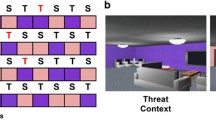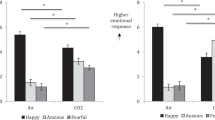Abstract
Rationale
This study aimed to test how expectations and anxiety sensitivity influence respiratory and autonomic responses to caffeine.
Objectives
The current study investigated the effects of expected vs. unexpected caffeine ingestion in a group of persons prone to the anxiety-provoking effect of caffeine (high anxiety sensitive persons, that is, persons scoring at least one SD above the mean on the Anxiety Sensitivity Index (Peterson and Reiss 1992)) as compared to low-anxious controls.
Methods
Autonomic arousal (heart rate, skin conductance level), respiratory responding (expired CO2, minute ventilation), and subjective report were assessed in high and low anxiety sensitive participants immediately after beverage consumption and at absorption peak (30 min post-consumption) in four separate sessions during which either coffee (expectation of caffeine) or bitter lemon soda (no expectation of caffeine) was crossed with 4 mg/kg caffeine vs. no drug.
Results
High and low anxiety sensitive persons showed comparable autonomic arousal and symptom reports to caffeine which was modulated by expectation, i.e., greater for coffee. Respiratory responding (CO2 decrease, minute ventilation increase) was more accentuated when caffeine was both expected and administered in the low anxiety sensitive group but more accentuated when caffeine was unexpectedly administered in the high anxiety sensitive group. Autonomic arousal and respiratory effects were observable within a few minutes after caffeine administration and were most pronounced at maximum absorption.
Conclusions
The results highlight the modulating role of expectancies in respiratory responding to caffeine in low vs. high anxiety sensitive persons and might have important implications for the better understanding of unexpected panic attacks.





Similar content being viewed by others
Notes
Low users were chosen for the study to exclude influences of conditioned responses to the taste or smell of coffee and to avoid effects of caffeine withdrawal in the context of overnight abstinence before assessments.
Description of startle data will be dealt with in an independent manuscript.
References
Alius MG, Pane-Farre CA, Von Leupoldt A, Hamm AO (2013) Induction of dyspnea evokes increased anxiety and maladaptive breathing in individuals with high anxiety sensitivity and suffocation fear. Psychophysiology 50:488–497
APA (2013) Diagnostic and statistical manual of mental disorders, 5th edn. American Psychiatric Publishing, Arlington
Benowitz NL (1990) Clinical pharmacology of caffeine. Annu Rev Med 41:277–288
Bouton ME, Mineka S, Barlow DH (2001) A modern learning theory perspective on the etiology of panic disorder. Psychol Rev 108:4–32
Dager SR, Layton ME, Strauss W, Richards TL, Heide A, Friedman SD, Artru AA, Hayes CE, Posse S (1999) Human brain metabolic response to caffeine and the effects of tolerance. Am J Psychiatry 156:229–237
DeMet E, Stein MK, Tran C, Chicz-DeMet A, Sangdahl C, Nelson J (1989) Caffeine taste test for panic disorder: adenosine receptor supersensitivity. Psychiatry Res 30:231–242
Eissenberg T, Griffiths RR (1997) Human drug discrimination and multiple chemical sensitivity: caffeine exposure as an experimental model. Environ Health Perspect 105(Suppl 2):509–513
Flaten MA, Blumenthal TD (1999) Caffeine-associated stimuli elicit conditioned responses: an experimental model of the placebo effect. Psychopharmacology (Berl) 145:105–112
Flaten MA, Aasli O, Blumenthal TD (2003) Expectations and placebo responses to caffeine-associated stimuli. Psychopharmacology (Berl) 169:198–204
Johnson PL, Samuels BC, Fitz SD, Federici LM, Hammes N, Early MC, Truitt W, Lowry CA, Shekhar A (2012) Orexin 1 receptors are a novel target to modulate panic responses and the panic brain network. Physiol Behav 107:733–742
Klein DF (1993) False suffocation alarms, spontaneous panics, and related conditions. An integrative hypothesis. Arch Gen Psychiatry 50:306–317
Lotshaw SC, Bradley JR, Brooks LR (1996) Illustrating caffeine’s pharmacological and expectancy effects utilizing a balanced placebo design. J Drug Educ 26:13–24
Lykken DT, Venables PH (1971) Direct measurement of skin conductance: a proposal for standardization. Psychophysiology 8:656–672
MacDonald AB, Stewart SH, Hutson R, Rhyno E, Loughlin HL (2001) The roles of alcohol and alcohol expectancy in the dampening of responses to hyperventilation among high anxiety sensitive young adults. Addict Behav 26:841–867
Masaoka Y, Homma I (2001) The effect of anticipatory anxiety on breathing and metabolism in humans. Respir Physiol 128:171–177
Masdrakis VG, Markianos M, Vaidakis N, Papakostas YG, Oulis P (2009) Caffeine challenge and breath-holding duration in patients with panic disorder. Prog Neuropsychopharmacol Biol Psychiatry 33:41–44
Melzig CA, Michalowski JM, Holtz K, Hamm AO (2008) Anticipation of interoceptive threat in highly anxiety sensitive persons. Behav Res Ther 46:1126–1134
Melzig CA, Holtz K, Michalowski JM, Hamm AO (2011) Interoceptive threat leads to defensive mobilization in highly anxiety sensitive persons. Psychophysiology 48:745–754
Mineka S, Hendersen RW (1985) Controllability and predictability in acquired motivation. Annu Rev Psychol 36:495–529
Paulus MP, Stein MB (2006) An insular view of anxiety. Biol Psychiatry 60:383–387
Peterson RA, Reiss S (1992) Anxiety sensitivity index manual, 2nd edn. International Diagnostic System, Worthington
Rapee R, Mattick R, Murrell E (1986) Cognitive mediation in the affective component of spontaneous panic attacks. J Behav Ther Exp Psychiatry 17:245–253
Rohsenow DJ, Marlatt GA (1981) The balanced placebo design: methodological considerations. Addict Behav 6:107–122
Schicatano EJ, Blumenthal TD (1995) The effects of different doses of caffeine on habituation of the human acoustic startle reflex. Pharmacol Biochem Behav 52:231–236
Silverman K, Griffiths RR (1992) Low-dose caffeine discrimination and self-reported mood effects in normal volunteers. J Exp Anal Behav 57:91–107
Telch MJ, Silverman A, Schmidt NB (1996) Effects of anxiety sensitivity and perceived control on emotional responding to caffeine challenge. J Anxiety Disord 10:21–35
Telch MJ, Smits JA, Brown M, Dement M, Powers MB, Lee H, Pai A (2010) Effects of threat context and cardiac sensitivity on fear responding to a 35% CO2 challenge: a test of the context-sensitivity panic vulnerability model. J Behav Ther Exp Psychiatry 41:365–372
Telch MJ, Harrington PJ, Smits JA, Powers MB (2011) Unexpected arousal, anxiety sensitivity, and their interaction on CO(2)-induced panic: further evidence for the context-sensitivity vulnerability model. J Anxiety Disord 25:645–653
van der Molen GM, van den Hout MA (1988) Expectancy effects on respiration during lactate infusion. Psychosom Med 50:439–443
Vilarim MM, Rocha Araujo DM, Nardi AE (2011) Caffeine challenge test and panic disorder: a systematic literature review. Expert Rev Neurother 11:1185–1195
Yang A, Palmer AA, de Wit H (2010) Genetics of caffeine consumption and responses to caffeine. Psychopharmacology (Berl) 211:245–257
Zvolensky MJ, Eifert GH (2001) A review of psychological factors/processes affecting anxious responding during voluntary hyperventilation and inhalations of carbon dioxide-enriched air. Clin Psychol Rev 21:375–400
Conflict of interest
This study was supported by the Department of Neuroscience at the University of Greifswald, Germany, and by a W. C. Archie Fund grant from Wake Forest University, USA. The authors declare no conflict of interest.
Author information
Authors and Affiliations
Corresponding author
Rights and permissions
About this article
Cite this article
Pané-Farré, C.A., Alius, M.G., Modeß, C. et al. Anxiety sensitivity and expectation of arousal differentially affect the respiratory response to caffeine. Psychopharmacology 232, 1931–1939 (2015). https://doi.org/10.1007/s00213-014-3828-3
Received:
Accepted:
Published:
Issue Date:
DOI: https://doi.org/10.1007/s00213-014-3828-3




